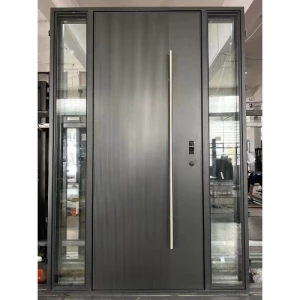Wholesale Interior Door With Glass
- Standard Size
- 2050*1500 (Accept Customization)
- Open Direction
- Inward/Outward/Left/Right
- Accessories
- Handle;Lock;Hinge;Peephole;Door Bell;Bolts
- The Finish of the Door
- Natural or technical veneer+painted wood
- Door Panel
- E1 5mm MDF
- Material
- Wood
The Main Purpose of Interior Door
Introduction:
Interior door serve multiple purposes within a building, contributing to its functionality, privacy, and overall design. In this discussion, we will explore the main purposes ofinterior door, highlighting their essential roles in defining spaces and enhancing the living or working environment.
1. Division and Separation:
One of the primary purposes of interior door is to divide and separate different areas within a building. By creating distinct rooms and compartments,interior door allow for privacy and organization. They act as physical barriers, preventing unrestricted access and defining individual spaces according to their intended functions.
2. Privacy and Security:
Knowing how to select the lock cylinder is very important to improve the safety factor. Interior door provide privacy within a building, ensuring that certain areas remain private and secluded. They create boundaries between public and private spaces, such as bedrooms, bathrooms, or offices, allowing individuals to retreat and have personal moments without intrusion. Moreover,interior door contribute to the overall security of a building, acting as a deterrent and preventing unauthorized access to specific areas.
3. Noise Control:
Interior door play a crucial role in controlling and reducing noise transmission between different rooms or areas. They help create acoustic barriers, minimizing the transfer of sound and creating a quieter and more comfortable environment. By providing a buffer against noise,interior door contribute to improved concentration, privacy, and overall well-being.
4. Climate Control:
Interior door also assist in climate control within a building. They help to contain heating or cooling within individual spaces, optimizing energy efficiency and maintaining desired temperatures. By preventing drafts and air movement between rooms,interior door contribute to better insulation and create a more comfortable and energy-conscious environment.
5. Design and Aesthetics:
Interior door are essential design elements that enhance the overall aesthetics of a building. The design of the room is different, and the choice of interior door frame will be different. They come in various styles, materials, and finishes, allowing for customization and integration with the desired interior design theme.interior door can serve as focal points or complementary features, adding visual appeal and contributing to the overall ambiance of the space.
Conclusion:
Interior door serve multiple purposes, including division and separation, privacy and security, noise control, climate control, and design enhancement. They play a vital role in defining spaces, ensuring privacy, improving comfort, and enhancing the overall functionality and aesthetics of a building. By fulfilling these purposes,interior door contribute to creating a harmonious and well-designed living or working environment.
We have more categories for you. lf you can't find the products you want above,just fill in the form and tell us whatproducts you want to import from China.




















